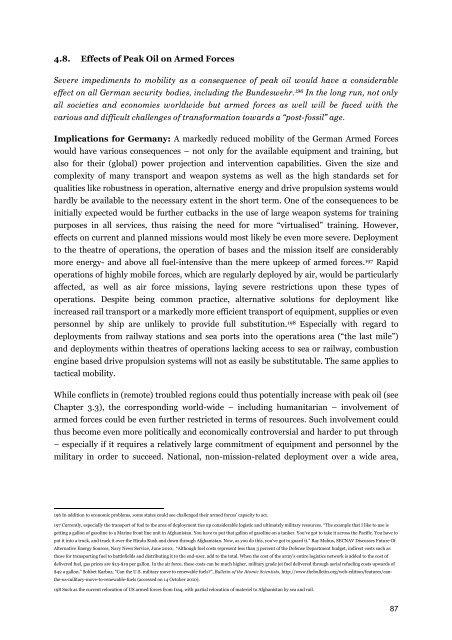PEAK OIL
PEAK OIL
PEAK OIL
Create successful ePaper yourself
Turn your PDF publications into a flip-book with our unique Google optimized e-Paper software.
4.8. Effects of Peak Oil on Armed Forces<br />
Severe impediments to mobility as a consequence of peak oil would have a considerable<br />
effect on all German security bodies, including the Bundeswehr. 196 In the long run, not only<br />
all societies and economies worldwide but armed forces as well will be faced with the<br />
various and difficult challenges of transformation towards a “post-fossil” age.<br />
Implications for Germany: A markedly reduced mobility of the German Armed Forces<br />
would have various consequences – not only for the available equipment and training, but<br />
also for their (global) power projection and intervention capabilities. Given the size and<br />
complexity of many transport and weapon systems as well as the high standards set for<br />
qualities like robustness in operation, alternative energy and drive propulsion systems would<br />
hardly be available to the necessary extent in the short term. One of the consequences to be<br />
initially expected would be further cutbacks in the use of large weapon systems for training<br />
purposes in all services, thus raising the need for more “virtualised” training. However,<br />
effects on current and planned missions would most likely be even more severe. Deployment<br />
to the theatre of operations, the operation of bases and the mission itself are considerably<br />
more energy- and above all fuel-intensive than the mere upkeep of armed forces. 197 Rapid<br />
operations of highly mobile forces, which are regularly deployed by air, would be particularly<br />
affected, as well as air force missions, laying severe restrictions upon these types of<br />
operations. Despite being common practice, alternative solutions for deployment like<br />
increased rail transport or a markedly more efficient transport of equipment, supplies or even<br />
personnel by ship are unlikely to provide full substitution. 198 Especially with regard to<br />
deployments from railway stations and sea ports into the operations area (“the last mile”)<br />
and deployments within theatres of operations lacking access to sea or railway, combustion<br />
engine based drive propulsion systems will not as easily be substitutable. The same applies to<br />
tactical mobility.<br />
While conflicts in (remote) troubled regions could thus potentially increase with peak oil (see<br />
Chapter 3.3), the corresponding world-wide – including humanitarian – involvement of<br />
armed forces could be even further restricted in terms of resources. Such involvement could<br />
thus become even more politically and economically controversial and harder to put through<br />
– especially if it requires a relatively large commitment of equipment and personnel by the<br />
military in order to succeed. National, non-mission-related deployment over a wide area,<br />
196 In addition to economic problems, some states could see challenged their armed forces’ capacity to act.<br />
197 Currently, especially the transport of fuel to the area of deployment ties up considerable logistic and ultimately military resources. “The example that I like to use is<br />
getting a gallon of gasoline to a Marine front line unit in Afghanistan. You have to put that gallon of gasoline on a tanker. You've got to take it across the Pacific. You have to<br />
put it into a truck, and truck it over the Hindu Kush and down through Afghanistan. Now, as you do this, you've got to guard it.” Ray Mabus, SECNAV Discusses Future Of<br />
Alternative Energy Sources, Navy News Service, June 2010; “Although fuel costs represent less than 3 percent of the Defense Department budget, indirect costs such as<br />
those for transporting fuel to battlefields and distributing it to the end-user, add to the total. When the cost of the army's entire logistics network is added to the cost of<br />
delivered fuel, gas prices are $13-$19 per gallon. In the air force, these costs can be much higher, military grade jet fuel delivered through aerial refueling costs upwards of<br />
$42 a gallon.” Sohbet Karbuz, “Can the U.S. military move to renewable fuels?”, Bulletin of the Atomic Scientists, http://www.thebulletin.org/web-edition/features/canthe-us-military-move-to-renewable-fuels<br />
(accessed on 14 October 2010).<br />
198 Such as the current relocation of US armed forces from Iraq, with partial relocation of materiel to Afghanistan by sea and rail.<br />
87


